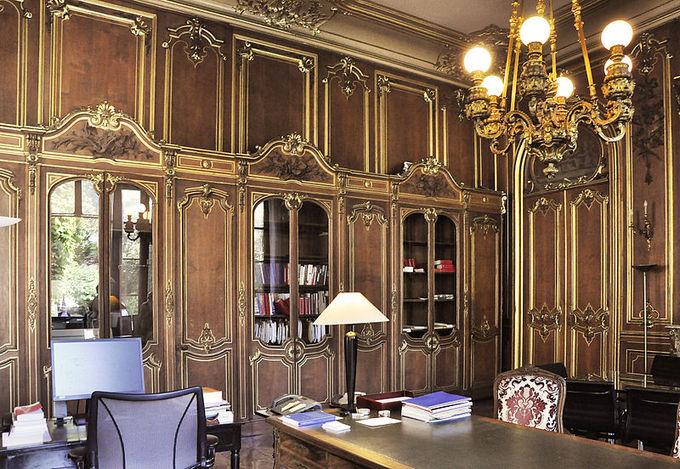7.3 Architecture
Rococo
In 18th century Europe, the Rococo style became prevalent in interior design, painting, sculpture, and the decorative arts. A reaction to the rigidity of Baroque style, the frivolous and playful Rococo first manifested itself with interior design and decorative work. In French, the word salon simply means living room or parlor, and Rococo salons refer to central rooms that are designed in the Rococo style. In addition, the notion of the ‘salon’ is an Enlightenment era ideal that transformed the living room into the central space for aristocracy to entertain guests and engage in intellectual conversation. The idea that one’s architectural surroundings should encourage a way of life, or reflect one’s values, was the philosophy of the time.
The Rococo interior reached its height in the total art work of the salon. Rococo salons are characterized by their elaborate detail, intricate patterns, serpentine design work, asymmetry, and a predisposition to lighter, pastel, and gold-based color palettes.
As another means of reflecting status, furniture rose to new heights during the Rococo period, emphasizing the lighthearted frivolity that was prized by the style. Furniture design became physically lighter, so as to be easily moved around for gatherings, and many specialized pieces came to prominence, such as the fauteuil chair, the voyeuse chair, and the berger et gondola. Furniture in the Rococo period was freestanding, as opposed to wall-based, in order to accentuate the lighthearted and versatile atmosphere that was desired by the aristocracy. Mahogany became the most widely used medium due to its strength, and mirrors also became increasingly popular.
Rococo salons often employed the use of asymmetry in design, which was termed contraste. Interior ornament included the use of sculpted forms on ceilings and walls, often somewhat abstract or employing leafy or shell-like textures. Two excellent examples of French Rococo are the Salon de Monsieur le Prince in the Petit Château at Chantilly, decorated by Jean Aubert; and the salons in the Hotel Soubise, Paris, by Germain Boffrand. Both of these salons exhibit typical Rococo style with walls, ceilings, and moulding decorated with delicate interlacings of curves based on the fundamental shapes of the ‘S,’ as well as with shell forms and other natural shapes.

Rococo architecture was a lighter, more graceful, yet also more elaborate version of Baroque architecture, which was ornate and austere. While the styles were similar, there are some notable differences between both Rococo and Baroque architecture, such as symmetry; Rococo emphasized the asymmetry of forms, while Baroque was the opposite. The styles, despite both being richly decorated, also had different themes; the Baroque was more serious, placing an emphasis on religion, and was often characterized by Christian themes (the Baroque began in Rome as a response to the Protestant Reformation); Rococo architecture was an 18th century, more secular, adaptation of the Baroque that was characterized by more light-hearted and jocular themes. Other elements belonging to the architectural style of Rococo include numerous curves and decorations, as well as the use of pale colors.
There are numerous examples of Rococo buildings as well as architects. Among the most famous include the Catherine Palace in Russia, the Queluz National Palace in Portugal, the Augustusburg and Falkenlust Palaces in Brühl, the Chinese House in Potsdam, the Charlottenburg Palace in Germany, as well as elements of the Château de Versailles in France. Architects who were renowned for their constructions using the style include Francesco Bartolomeo Rastrelli, an Italian architect who worked in Russia and who was noted for his lavish and opulent works, Philip de Lange, who worked in both Danish and Dutch Rococo architecture, or Matthäus Daniel Pöppelmann, who worked in the late Baroque style and who contributed to the reconstruction of the city of Dresden in Germany.
Catherine Palace in Tsarskoe Selo, Saint Petersburg: The residence originated in 1717, when Catherine I of Russia hired German architect Johann-Friedrich Braunstein to construct a summer palace for her pleasure. In 1733, Empress Elizabeth commissioned Mikhail Zemtsov and Andrei Kvasov to expand the Catherine Palace. Empress Elizabeth, however, found her mother’s residence outdated and incommodious and in May 1752 asked her court architect Bartolomeo Rastrelli to demolish the old structure and replace it with a much grander edifice in a flamboyant Rococo style. Construction lasted for four years, and on July 30, 1756 the architect presented the brand-new 325-meter-long palace to the Empress, her dazed courtiers, and stupefied foreign ambassadors. Provided by: Wikimedia. Located at: commons.wikimedia.org/wiki/File:Catherine_Palace_in_Tsarskoe_Selo_02.jpg. License: CC BY: Attribution
Rococo architecture also brought significant changes to the building of edifices, placing an emphasis on privacy rather than the grand public majesty of Baroque architecture, as well as improving the structure of buildings in order to create a more healthy environment.
28.2: Rococo is shared under a CC BY-SA 4.0 license and was authored, remixed, and/or curated by LibreTexts.
Neoclassical Period
Neoclassical architecture, which began in the mid 18th century, looks to the classical past of the Graeco-Roman era, the Renaissance, and classicized Baroque to convey a new era based on Enlightenment principles. This movement manifested in its details as a reaction against the Rococo style of naturalistic ornament, and in its architectural formulas as an outgrowth of some classicizing features of Late Baroque. In its purest form, Neoclassicism is a style principally derived from the architecture of Classical Greece and Rome. In form, Neoclassical architecture emphasizes the wall and maintains separate identities to each of its parts.
The first phase of Neoclassicism in France is expressed in the Louis XVI style of architects like Ange-Jacques Gabriel (Petit Trianon, 1762–68). Ange-Jacques Gabriel was the Premier Architecte at Versailles, and his Neoclassical designs for the royal palace dominated mid 18th century French architecture.
After the French Revolution, the second phase of Neoclassicism was expressed in the late 18th century Directoire style. The Directoire style reflected the Revolutionary belief in the values of republican Rome. This style was a period in the decorative arts, fashion, and especially furniture design, concurrent with the post-Revolution French Directoire (November 2, 1795–November 10, 1799). The style uses Neoclassical architectural forms, minimal carving, planar expanses of highly grained veneers, and applied decorative painting. The Directoire style was primarily established by the architects and designers Charles Percier (1764–1838) and Pierre-François-Léonard Fontaine (1762–1853), who collaborated on the Arc de Triomphe in Paris, which is considered emblematic of French neoclassical architecture.
Arc de Triomphe: The Arc de Triomphe, although finished in the early 19th century, is emblematic of French neoclassical architecture that dominated the Directoire period.
Though Neoclassical architecture employs the same classical vocabulary as Late Baroque architecture, it tends to emphasize its planar qualities rather than its sculptural volumes. Projections, recessions, and their effects on light and shade are more flat. Sculptural bas-reliefs are flatter and tend to be framed in friezes, tablets, or panels. Its clearly articulated individual features are isolated rather than interpenetrating, autonomous, and complete in themselves.
Even sacred architecture was classicized during the Neoclassical period. The Panthéon, located in the Latin Quarter of Paris, was originally built as a church dedicated to St. Geneviève and to house the reliquary châsse containing her relics. However, during the French Revolution, the Panthéon was secularized and became the resting place of Enlightenment icons such as Voltaire and Jean-Jacques Rousseau. Designer Jacques-Germain Soufflot had the intention of combining the lightness and brightness of the Gothic cathedral with classical principles, but its role as a mausoleum required the great Gothic windows to be blocked. In 1780, Soufflot died and was replaced by his student, Jean-Baptiste Rondelet.
Similar to a Roman temple, the Panthéon is entered through a portico that consists of three rows of columns (in this case, Corinthian) topped by a Classical pediment. In a fashion more closely related to ancient Greece, the pediment is adorned with reliefs throughout the triangular space. Beneath the pediment, the inscription on the entablature translates as: “To the great men, the grateful homeland.” The dome, on the other hand, is more influenced by Renaissance and Baroque predecessors, such as St. Peter’s in Rome and St. Paul’s in London.
Intellectually, Neoclassicism was symptomatic of a desire to return to the perceived “purity” of the arts of Rome. The movement was also inspired by a more vague perception (“ideal”) of Ancient Greek arts and, to a lesser extent, 16th century Renaissance Classicism, which was also a source for academic Late Baroque architecture. There is an anti-Rococo strain that can be detected in some European architecture of the earlier 18th century. This strain is most vividly represented in the Palladian architecture of Georgian Britain and Ireland.
Lord Burlington. Chiswick House: The design of Chiswick House in West London was influenced by that of Palladio’s domestic architecture, particularly the Villa Rotunda in Venice. The stepped dome and temple façade were clearly influenced by the Roman Pantheon.
The trend toward the classical is also recognizable in the classicizing vein of Late Baroque architecture in Paris. It is a robust architecture of self-restraint, academically selective now of “the best” Roman models. These models were increasingly available for close study through the medium of architectural engravings of measured drawings of surviving Roman architecture.
28.3: Neoclassicism is shared under a CC BY-SA 4.0 license and was authored, remixed, and/or curated by LibreTexts.

